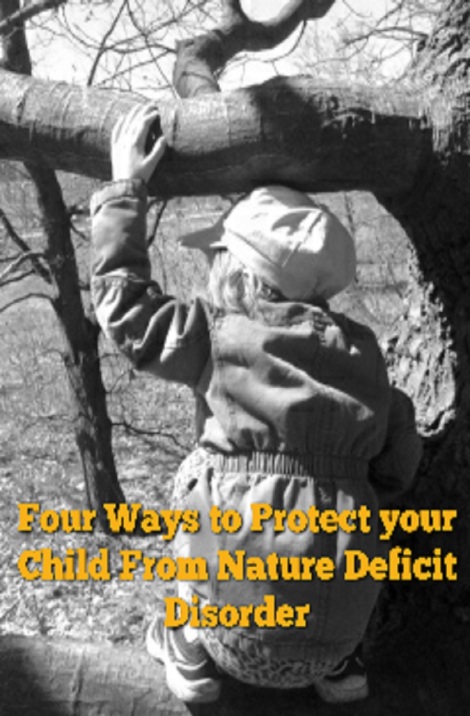So, what does “Nature Deficit Disorder” mean? It is a term proposed by Richard Louv in his book, “Last Child in the Woods”. He uses it to describe the chasm forming between the children of today and nature, and how this is having detrimental effects on their behavior. One main factor is that children are now drowning in technology. Each day the average North American child spends less than 30 minutes outside and more than 7 hours in front of a screen. How do we start to fix it? We start with ourselves and our children. Here are four pointers on how to do that.
Sharing with Others
One of Louv’s suggestions is to put together a “Family Nature Club”. This is a good way to motivate yourself and others to get outside, and build up a community while at it. Examples of activities you may meet up for include: paddling, going for hikes, and camping trips. One might organize a group like this through a social media platform like Facebook. On the Children and Nature Network website, you can sign up to be included in a community forum where environmentally minded people knock around their ideas. Recently I organized an outside activity for local children and you can read about it in my post, “Survival in the Woods“!
Using Technology

When outdoor fun isn’t happening, and your child is slumped over their tablet or computer, there are websites they can connect with nature to. One of these is Jane Goodall’s Roots and Shoots, a site they can stop in at to explore how youth around the globe are actively helping out our natural world. National Geographic Kids has a virtual interactive game called Animal Jam, where a child can travel through different lands learning a variety of nature-related facts.
Reading Books

Another engaging activity that can be pursued whether indoors or out is to snuggle up with your child and become absorbed by a nature book. The following are good suggestions:
“Owl Moon”, by Jane Yolen:
A father and daughter take a walk in the woods making occasional stops to mimic the call of a Great Horned Owl. They are eventually rewarded with a brief encounter.
“Wolf Island”, by Cecilia Godkin:
A family of wolves leave an island for the mainland and it is demonstrated how the ecosystem changes with their disappearance.
Here are some other books with beautiful illustrations on this theme.
Keeping it Simple

There is also something simple one can do, and it is this: Let them play outside. There are doors in buildings and those lead to fresh air, and even in the biggest cities, some kind of nearby green space. Once upon a time children regularly ventured outside to run through and explore fields, climb trees, and simply observe a colony of ants. In today’s busy, technologically distracting world, nature is where they can center themselves.
Finally, “Nature Deficit Disorder” is just an accurate way to describe the current problem of children not getting a large enough dose of nature in their daily lives. The issue itself seems simple enough and, hopefully, can be easily reversed. Expose your child to the natural world in any way you can. This does nothing but benefit them and nature, both of which deserve it.

Leslie I love this post. It coincides well with one I wrote on my site. I will create a ping back on my post to yours. Looking forward to following you and maybe pinging and linking your posts and site to mine. Great stuff! Keep going!!
LikeLike
I am very excited for this feedback! I just started out on this venture and am still learning how to navigate… I am not even sure how to ‘ping’ and ‘link’ but I am meeting up with a blogger friend tomorrow who is going to help me out a bit. So I would love to. And thanks for the encouragement!
LikeLike
I just linked your post to my post on stepping away from the screen by creating a hyperlink to your post in my last paragraph!!!! 😉
LikeLike
oh okay cool. Thanks!
LikeLiked by 1 person
Pingback: Step Away from the Screen and Into the Green: 5 Family Resources for Increasing Green Time – EARLY CHILDHOOD EDU-PLAY-TION·
Reblogged this on EARLY CHILDHOOD EDU-PLAY-TION and commented:
This blog is one I have just recently discovered and absolutely love it. Check it out and show Leslie some love!!! She is just getting started so please share and reblog this!
LikeLike
Excellent, excellent, post. Many years ago, a friend mentioned ‘Last child in the Woods’ along with the term “Nature Deficit Dosorder”. Not long after that, our son wasDX’ed with Aspergers. It was recommended that we get him to a nature environment. So we moved to Evergreen … We live ” 8800 feet … Surrounded by trees … Thus, the name of my blog “Other Side of the Trees”. Thanks for visiting my blog. You have a good one yourself… I’ll be back.
LikeLiked by 1 person
Thanks so much for visiting! I am glad to hear that has helped your son. I will definitely be keeping an eye on your blog as well.
LikeLike
How awesome are you, helping to facilitate such a fun learning experience.
LikeLike
Great to see mention of parents, and groups. I would also encourage parents to lead by example, rather then just trying to organize outings, which are a bit like school. Parents with ‘nature deficit disorder’ who don’t get outside will have a much harder time getting their kids out the door. ‘Get outside and play!’ ain’t
gonna cut it.
LikeLike
Very important aspect for adults to lead on that. 🙂
LikeLike